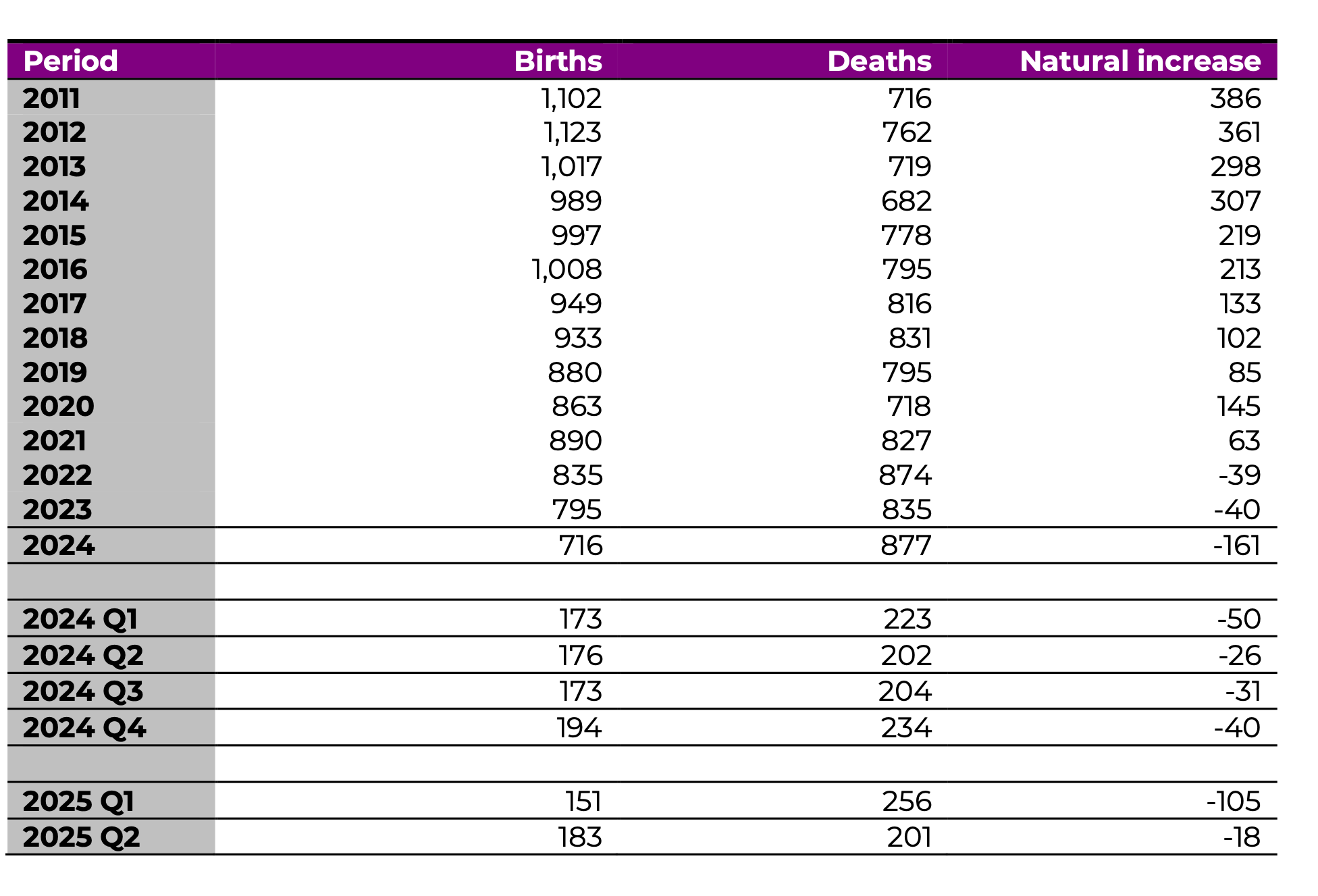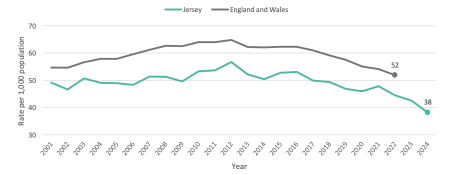News
Why has the number of births in Jersey fallen?
The number of births in Jersey has fallen dramatically in recent years. This note sets out the data and examines the causes of the decline.
Summary
- The number of births in Jersey has fallen from a peak of 1,123 in 2012 to 716 in 2024.
- The number of births fell by 10% in 2024; in the first half of 2025 births were 4% lower than in the first half of 2024.
- Until 2021 births in Jersey always exceeded deaths. However, deaths have exceeding births by 39 in 2022, 40 in 202 and 161 in 2014; a figure of over 200 is likely in 2025.
- Between 2021 and 2024 the number of births in Jersey fell by 20% compared with just 5% in England and Wales. In 2024 alone while births fell by 10% in Jersey they increased by 1% in England and Wales.
- Births in Guernsey and the Isle of Man have fallen much more than in England and Wales although less than in Jersey.
- Any decline in births is caused by one or both of a fall in the number of live births per woman of childbearing age and emigration and immigration of young people. It is likely that the sharp decline in births in 2024 is partly explained by the migration issue.
- The number of pupils attending primary schools is likely to fall by 20% between 2021 and 2028. This has significant implications for the primary school structure, given that Jersey has several small primary schools with under 200 pupils. There will also be a reduced demand the secondary education in due course.
- In the short term the fall in the number of births will reduce the dependency ratio but from the mid-2030s it is likely to cause a significant increase in the ratio.
Statistics on births in Jersey
The Annual Statement of the Superintendent Registrar, published on 31 January 2025, showed that there were 716 births in 2024, a 10% fall on the 2023 figure and a 36% fall on the peak figure of 1,123 recorded in 2012. The number of deaths in 2024 was 877, so the natural decrease in population was 162.
The following table shows births and deaths recorded in Jersey since 2011.

Source: Annual statements of the Superintendent Registrar for the annual figures, Freedom of Information responses, 24 April 2025 and 28 July 2025, for the quarterly figures.
The number of births fell to a new low in the first half of 2025. 334 births were recorded, 4% lower than the figure recorded in the first half of 2024. Deaths have shown the opposite trend. 457 deaths were recorded, an increase of 4% on the figure a year earlier. Deaths therefore exceeded births by 123 compared with 76 in 2024. Until 2021 births in Jersey always exceeded deaths. This has since been reversed, deaths exceeding births by 39, 40 and 161 in the last three years. With the figure of 123 in the first half alone, it is likely that the figure for the year as a whole will be over 200. It will be noted that there is considerable variation in the quarterly figures. Births in the first quarter were 13% lower than a year earlier while in the second quarter they were slightly higher.
Comparative data
Jersey’s experience is similar to that in the other Crown Dependencies but different from that in England and Wales. The following table shows the key data.
Crown Dependencies and England and Wales, births, 2016-2024

Note: Neither Guernsey nor the Isle of Man publish annual figures for births in a consistent and accessible way. Different sources give slightly different figures.
Between 2016 and 2021 the number of births in Jersey declined by 11.7%, similar to the England & Wales figure of 10.3%. However, between 2021 and 2024 the number of births in Jersey fell by 20.3% compared with just 4.8% in England and Wales. And in 2024 alone births fell by 9.9% in Jersey but actually increased by 0.6% in England and Wales.
Births in Guernsey and the Isle of Man have fallen much more than in England and Wales although less than in Jersey.
Reasons for the decline in the number of births
At first sight it is difficult to explain what has happened since 2021 that has caused such a marked divergence between the Crown Dependencies and England and Wales. Any decline in births must be caused by one or both of two factors – a fall in the general fertility rate (GFR), the number of live births per woman of childbearing age (typically 15-44), and emigration and immigration of young people.
There is some useful data on this in the Births and Breastfeeding Profile 2024 published by Public Health Jersey on 3 July 2025. The GFR in Jersey in 2024 was 38 births for every 1,000 women of childbearing age. For comparison, the GFR in England and Wales was higher at 52 births per 1,000 women of childbearing age in 2022. The following graph is reproduced from the report.

Unfortunately there are no figures for England and Wales for 2023 and 2024 but generally the trend in Jersey seems similar to that in England and Wales. (A slight note of caution here. It is not clear that accurate figures exist for the number of women of child-bearing age. This is significant because of the impact of migration.)
Other things being equal an increase in net immigration of young people is likely to lead to an increase in the number of births even if the GFR remains unchanged. Conversely, a rise in net emigration of young people is likely to lead to a fall in the number of births. This seems a plausible explanation for part of the different experiences of the Crown Dependencies and England and Wales since 2021.
While this might be attributed, as it is anecdotally in Jersey, to high housing costs this is not a new phenomenon and indeed in nominal terms average house prices have fallen by 14.2% since the peak in 2022 Q3. Inflation in that period has been 15.0% so in real terms house prices have fallen by 25.3%. Average rents have fallen by 7.1% since their peak in 2022 Q3 and in real terms by 19.1%.
It may be the period of lockdown during the pandemic has significantly changed attitudes to migration.
Implications
The initial impact of the decline in the number of births will be on the demand for early years services and the numbers attending primary schools. This will feed through to the demand for secondary school places after an appropriate interval.
The number of primary school students peaked at 8,054 in 2021, reflecting the high number of births between 2011 and 2016. The number fell to 7,441 in 2024 and given trends in the number of births is likely to have fallen to around 7,000 in 2025 and will fall further to around 6,500 in 2028. This 20% reduction in a period of just seven years clearly has significant implications for primary school enrolment. Jersey has an unusual structure of primary school provision. There are 24 separate schools with an average of 254 students at each. However six of the schools have over 350 students while nine have fewer than 200. In the two years to Spring 2025 the number of primary school pupils fell by 5.6%, four schools recording declines in excess of 10%.
There may well be a need for some restructuring particularly among the smaller schools. If a fairly constant pupil/teacher ratio is maintained then there should be a corresponding fall in the cost of education. However, in practice there will be pressure for smaller class sizes rather than fewer schools.
The latest population projections, published in 2023, estimated that with net nil migration the number of people aged under 16 would fall from 16,000 in 2020 to 13,800 in 2040 and even with net inward migration of 325 a year would still fall to 13,900.
Assuming no significant increase in net immigration, in the short term the fall in the number of births will lower the dependency ratio but from the mid-2030s the opposite will occur with fewer young people beginning to work while at the same time the number of people who have retired continues to increase.
Policy options
The Chief Minister has already indicated that the fall in the number of births is a government priority but at first sight it is difficult to see what government can do. There is no scope for financial incentives for people to have more children. There might be more scope to reduce the costs of raising children by more generous childcare provisions. More generally, if the high cost of living in Jersey is causing a reduction in the number of young people who might otherwise have chosen to live in Jersey to choose not to do so then this can be tackled only by measures to reduce the cost of living, specifically the cost of housing.

